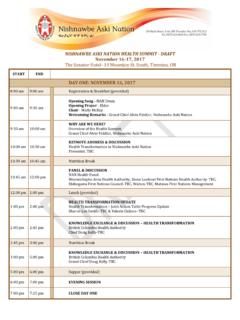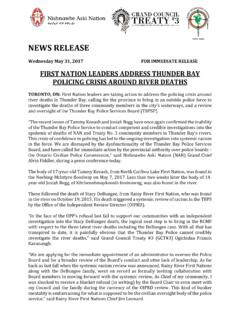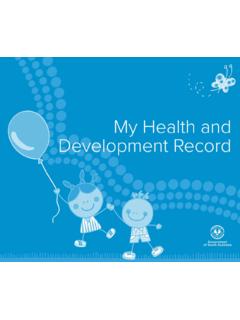Transcription of Education Partnerships Program Life Skills and …
1 Skills and Transitions CurriculumMarch 2015 life Long LearningEducation Partnerships Program Table of Contents Introduction .. 2 curriculum Implementation Suggestions .. 3 Grade 7 life Skills and Transitions Activity Overview .. 4 Grade 7 life Skills and Transitions Resources .. 5 Activity 1: Respect: Self-esteem & Self-confidence .. 6 Activity 2: Problem Solving .. 9 Activity 3: Decision Making .. 13 Activity 4: Looking Past Tomorrow and Today .. 16 Activity 5: Online Etiquette .. 19 Activity 6: Telephone Skills .. 22 Grade 8 life Skills and Transitions Activity Overview.
2 26 Grade 8 life Skills and Transitions Resources .. 27 Activity 1: Respecting Community & Property .. 29 Activity 2: Urban Settings .. 32 Activity 3: Making Plans for the Future .. 37 Activity 4: Social Leisure: Friendship, Social Interaction & Emotions .. 40 Activity 5: Asking Questions & Finding Answers .. 44 2 life Skills and Transitions curriculum NAN Education Partnerships Program Introduction The purpose of the life Skills and Transitions curriculum is to help students and young people develop the Skills needed to cope in the world.
3 The main topics in this curriculum are heavily researched and accepted areas of need for development. These topics are expanded in units developed for Grade 7 and Grade 8 students. The life Skills and Transitions curriculum is organized around five week blocks that can be accomplished in their respective grades at any time during the school year. This curriculum can be used as an intensive study in some areas, a general study in other areas, or a combination of both. One of the goals of the life Skills and Transitions curriculum is to provide instruction that supports the students transition into community and adult life .
4 Every activity has opportunities to make community connections and life in the community important and relevant. The Grade 7 and Grade 8 units include cultural components relevant to many communities and can be adapted to meet the needs of any community. It is intended that the content be adapted to meet the cultural needs of the students and that they find information that helps them be good, healthy community members. Included in this curriculum are activities derived from various topics. Each activity includes expectations, teaching/learning strategies, adaptations and assessments, and resources suitable for all students.
5 In implementing this life Skills and Transitions curriculum ; note that the scope and sequence is extensive and yet open-ended for whatever class you might have. 3 life Skills and Transitions curriculum NAN Education Partnerships Program curriculum Implementation Suggestions A. Review the entire curriculum Read through the activity overviews at the beginning of the each grade. Determine the special needs that your students may have and list these needs so that they may be addressed as you proceed. Decide what topics you might be able to use for the time you have been allotted for the class.
6 Some of the topics in each unit may need more time but all topics should be covered by all students. Adaptations and modifications have been included to address their needs. B. Determine a plan Plan out the number of classes needed for the unit. Organize the materials required. Choose activities that suit the needs of the students. Change these if necessary. Review the assessments listed and choose methods of evaluating the students. Ensure that the resources listed are downloadable. Involve people from the community if they can be helpful to you and your students.
7 Encourage independence with the students and decision making on their part. At times it may be valuable to have students help pick additional topics of their choice. C. Review the resources Each topic has a number of resources online. There is no need for textbooks and this keeps costs to a minimum. There are some materials needed such as cameras but costs for these should be minimal. The resources listed are pertinent for the students in our communities. They have cultural aspects and follow what is currently relevant for young adults, , the topic of online etiquette is very relevant and deals with the hard topics of cyberbullying and chatting.
8 The life Skills and Transitions curriculum is designed to be teacher friendly and student useful. Students need to feel successful and this curriculum allows for that in every activity and for every topic. The Grade 7 unit may be taught as part of the Health & Physical Education curriculum , while the Grade 8 unit may be taught alone or perhaps as a locally developed option. It is vital that students learn this information before they enter the world outside of their home communities. 4 life Skills and Transitions curriculum NAN Education Partnerships Program Grade 7 life Skills and Transitions Activity Overview The activities listed below are designed to support all students in becoming successful contributing members of society on- and off-reserve.
9 Activity 1: Respect: Self-esteem & Self-confidence (5 classes or 150 minutes) Activity 2: Problem Solving (5 classes or 150 minutes) Activity 3: Decision Making (5 classes or 150 minutes) Activity 4: Looking Past Tomorrow and Today (5 classes or 150 minutes) Activity 5: Online Etiquette (3 classes or 90 minutes) Activity 6: Telephone Skills (2 classes or 60 minutes) 5 life Skills and Transitions curriculum NAN Education Partnerships Program Grade 7 life Skills and Transitions Resources TOPIC RESOURCE RESPECT: SELF ESTEEM & SELF CONFIDENCE What is respect?
10 10 tips for improving self-esteem Games to help build self-respect Self-respect quotes PROBLEM SOLVING Problem solving Skills DECISION MAKING Decision making techniques Decision making: An introduction Decision making Skills & techniques guide LOOKING PAST TOMORROW AND TODAY How to do a job search Top ten dos and don`ts for a job search Career profiles info Canada careers ONLINE ETIQUETTE What is netiquette? Netiquette rules safety sheet Game safety Cyberbullying TELEPHONE Skills Local telephone books 6 life Skills and Transitions curriculum NAN Education Partnerships Program Activity 1: Respect: Self-esteem & Self-confidence Time: 5 classes or 150 minutes EXPECTATIONS: The students will understand the concept of respect and develop a sense of self-respect, self-esteem, and self-worth.



